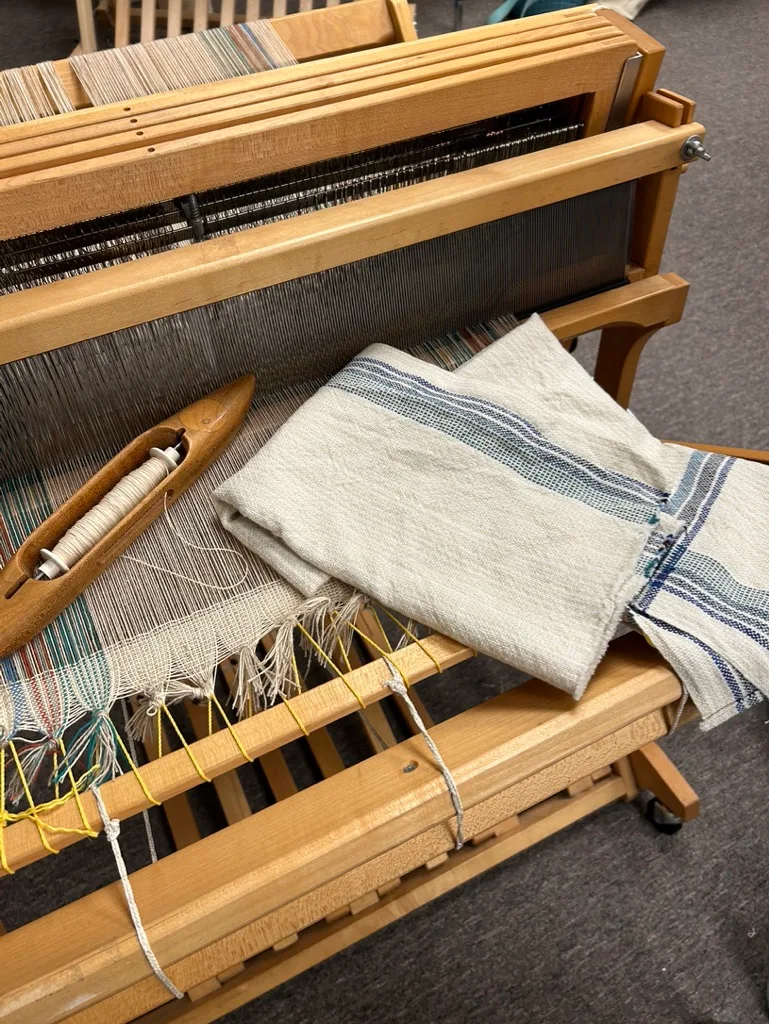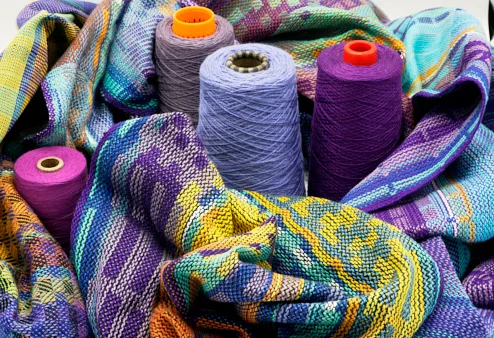The Wonders of Weft on a Small Loom

by Myra Wood
Supplementary-weft weaving has been around for a very long time. There’s evidence of it in some of the earliest weavings from India and Egypt including in the tomb of Tutankhamun. The idea of creating a decorative fabric by weaving a simple tabby cloth simultaneously with a contrasting, superimposed pattern has shown up in cultures worldwide; Latin American brocades, Branoe or branded folk weaving from Russia, Smalandsvav in Sweden and Skillbragd in Norway inlay/overshot techniques, Sanga and Songket from Southeast Asia, Saga Nashiki from Japan, traditional Slavic weaves often used for belts, and American overshot coverlets from the 18th century all create a similar fabric structure using variations of decorative supplementary weft over a plain, tabby background. Many of these techniques even have motifs in common, despite being separated by great distance and time, most likely due to human migration. As is the tradition with many crafts, each province, prefecture, county and clan typically used a specific weaving designs to distinguish the area where it was made.

There are techniques that use a more freeform approach, like the figurative works from Peru, Mexico, and Guatemala, as well as many from India called weft-float patterns. These fabrics usually include individual figures or animals and are woven with a discontinuous supplementary weft. A distinction can be made for color changes across a row, between continuous supplementary wefts, where the pattern weft continues from selvedge to selvedge, and discontinuous supplementary wefts, where the pattern weft only travels across a portion of the row. Most discontinuous styles use different colors traveling partially across the same rows similar to tapestry weaving, to create different figures.
One night, while browsing weaving videos on Youtube, as I often do, I stumbled on the little known technique called Branoe weaving from Russia. I love the rigid heddle for it’s ease and portability and especially for the small commitment with speedy dressing that gets me weaving in a very short time. I quickly realized while watching all of Kelly Casanova’s fascinating videos on Branoe weaving that something about it was very familiar. I also love to do Fair Isle, stranded and mosaic knitting. Each is done by following a simple gridded chart and working one stitch at a time across a row to create a beautifully patterned fabric. I tried the Branoe technique from the video and ventured off into a rabbit hole that I still haven’t emerged from that resulted in a book called “Crazyshot!- Creative Overshot Weaving for the Rigid Heddle Loom,” – a deep dive into combining traditional charts from various fiber arts and the Branoe/overshot styles of weaving.
Simply put the cloth is woven by alternating picks of tabby weave that match the warp in weight and color with a heavier yarn that follows a chart for a patterned relief that sits on the surface of the fabric. One of the coolest things about this method is that the fabric is entirely reversible since the pattern sits over both the front and the back. While it’s definitely a labor of love to sit and pick every other row individually, I find it very meditative and rewarding. Most forms of overshot weaving on the rigid heddle loom, where the fabric and decoration are woven together with different thicknesses of thread or yarn, usually entail a laborious preset of multiple warps and or heddle rods with string heddles mimicking a four shaft loom. Because rigid heddle looms typically only accommodate one or two heddles, additional pick-up sticks or heddle rods with string heddles are often employed. There are even some methods where three heddles are employed and used in various combinations to duplicate all four shafts. In this case the overall design is predetermined and warping through each heddle follows a very specific route based on the pattern chosen. One mistake in warping can cost you the entire outcome of the fabric.
What makes Branoe and the simple supplementary-weft techniques so exciting and accessible to anyone who can weave a plain cloth is that it uses only one heddle and one pick-up stick to create complex-looking patterns with endless variations. A multitude of patterns can be created including some which would be impossible to weave on a multi shaft loom. It’s also very easy to correct mistakes by watching each row as you weave, much like knitting, and unweaving incorrect rows before you progress.
Because fabrics made with a supplementary-weft techniques tend to be thicker and firmer than plain weaves, most are used for decorative home goods and accessories. These fabrics may not be suitable for clothing, where drape is a concern, but can be used as beautiful borders. I’m currently experimenting with weaving different weights of thread and yarn to see if I can produce a more wearable fabric. The adventure continues! More info about Crazyshot with lots of photos can be seen at: myrawood.com/crazyshot





Can this be adapted to a tapestry loom?
You can ask her yourself! She’s speaking at the guild February 12. If you aren’t a member send a zoom request to info @ pghw.org and we can admit you to the meeting. She is also running a workshop in Philadelphia. It’s on our calendar.